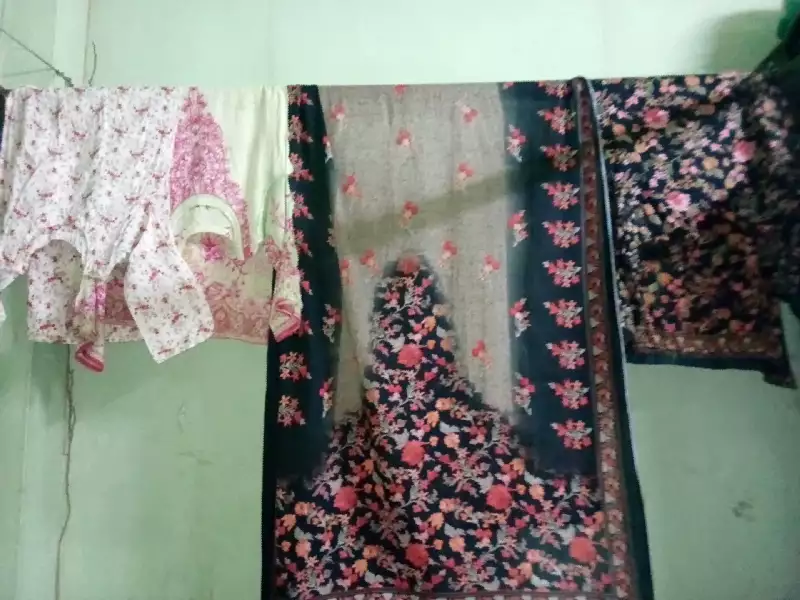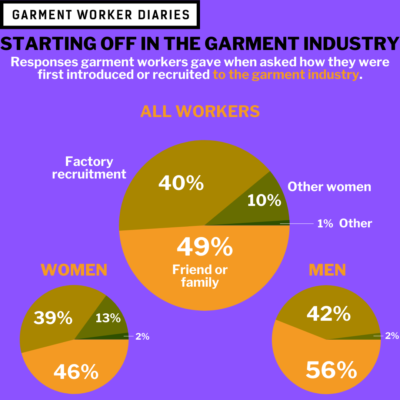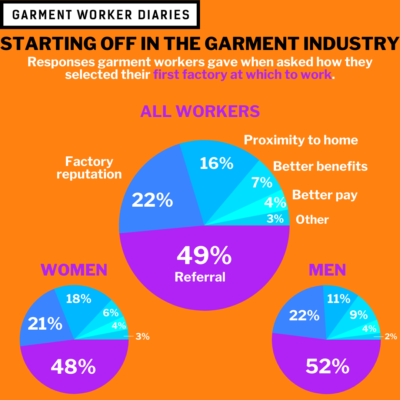At the end of July 2021, MFO and SANEM asked garment workers in Bangladesh a set of special questions developed alongside one of our partners. We wanted to know the criteria by which garment workers select the factory at which they will work, and how they got started in the industry in the first place. Here’s what we learned:
Note: Banner photo courtesy of a garment worker in Dhaka; numbers in graphs and lists may not sum to 100% due to rounding.
Starting in the RMG Sector
We began by asking our pool of 1,282 garment workers how they were first introduced or recruited to the garment industry. Comparing answers between women and men, men were somewhat more likely to say that a friend or family member introduced them to the industry, and women were somewhat more likely to say that it is simply the occupation that other women in their neighborhood or community have. Here are the combined responses from all women and men:
- 49% said a friend or family member introduced them
- 40% said the factory recruited them (examples of factory recruitment workers gave were recruitment notices, advertisements on posters or otherwise, and loudspeaker notices)
- 10% said that most women in their neighborhood or community work in the garment industry
- 1% gave us some other response
First Factory
We asked that same pool of garment workers to think back to when they first started working in the RMG sector and specifically to the first factory they worked in. Here is how they decided which factory to join:
- 49% said they decided based on a referral from someone working at the factory
- 22% said the reputation of the factory helped them decide
- 16% said the proximity of the factory to their home was the deciding factor
- 7% said the factory they chose had better benefits than other factories
- 4% said the factory they chose had better pay than other factories
- 3% made the decision via some other means
Women were slightly more likely to list proximity to home as a factor and men were slightly more likely to say they’d been referred, but otherwise women’s and men’s answers were similar.
Among the 49% of workers who selected their first factory to work at based on a referral from someone already working at the factory, here is who referred them:
- 32% were referred by a family member
- 31% were referred by a friend living in the same area
- 17% were referred by an acquaintance living in the same area
- 12% were referred by an acquaintance living somewhere else
- 6% were referred by a friend living somewhere else
- 2% were referred by some other type of contact
Women were slightly more likely to list a family member as a referral and men an acquaintance in another area, but otherwise answers were similar.
Beyond the primary motivator driving workers’ selection of their first factory at which to work, we wanted to know if there were additional motivating factors. We posed this question to all 1,282 workers and they were allowed to select as many additional influences on their decision to join their first factory as they liked. Here is what they told us (answers for women and men were very similar):
- 43% told us there were no secondary factors driving their decision beyond the main factor
- 14% told us the reputation of the factory was another influence on their decision
- 14% told us that the superior benefits were another influence on their decision
- 13% told us the proximity of the factory to home was another factor
- 9% told us that the better pay was another factor
- 6% told us that a referral from someone already working in the factory was also an influence
- 1% told us some other factors influenced to choose their first factory
And for the 6% of workers who said that, in addition to the prime factor influencing their decision a referral was a secondary motivator, here is their relationship to that person who referred them:
- 32% were referred by a friend living in the same area
- 30% were referred by a family member
- 20% were referred by an acquaintance living in the same area
- 12% were referred by a friend living somewhere else
- 5% were referred by an acquaintance living somewhere else
- 1% were referred by some other type of contact
Current Factory
The majority of garment workers do not stay at one factory for their entire careers. So we also asked garment workers to tell us how they decided to become a part of the workforce in their current factory. 45% told us they had never changed factories and were still working at their first factory, while the remaining 55% said they’d moved on from their first factory. Here’s what that 55% told us (there was little difference between the answers women and men gave us regarding these remaining “current factory” questions):
- 27% said that better pay led them to their current factory
- 16% said that better benefits led them to their current factory
- 15% said proximity to home led them to their current factory
- 14% said the reputation of the factory led them to take a job there
- 13% said that a referral from someone working at their current factory was the deciding factor
- 7% said that their current factory offered them a better position than their previous factory
- 8% said some other factor drove their decision to join up with their current factory
Among the 7% of workers who selected their current factory to work at based on a referral from someone already working at the factory, here is who referred them:
- 36% were referred by a friend living in the same area
- 28% were referred by a family member
- 17% were referred by an acquaintance living somewhere else
- 10% were referred by an acquaintance living in the same area
- 7% were referred by a friend living somewhere else
- 3% were referred by some other type of contact
Beyond that primary motivator driving garment workers to move on and choose a new factory to work at, here are the other motivations that influenced their decisions:
- 20% told us there were no other factors
- 21% told us that the superior benefits were another influence on their decision
- 19% told us that the better pay was another factor
- 12% told us the proximity of the factory to home was another factor
- 11% said that being offered a better position was another factor
- 9% told us the reputation of the factory was another influence on their decision
- 4% told us some other factors influenced to choose their first factory
- 3% told us that a referral from someone already working in the factory was also an influence
Lastly, for the 3% of workers who said a referral also influenced them to take their current factory job:
- 30% were referred by a family member
- 27% were referred by a friend living in the same area
- 18% were referred by an acquaintance living in the same area
- 9% were referred by an acquaintance living somewhere else
- 9% were referred by some other type of contact
- 6% were referred by a friend living somewhere else
The data used for the analysis presented here come from interviews conducted over the phone on July 30, 2021 with a pool of 1,282 workers. These workers are employed in factories spread across the five main industrial areas of Bangladesh (Chittagong, Dhaka City, Gazipur, Narayanganj, and Savar). Just over three-quarters of the working respondents are women, roughly representative of workers in the sector as a whole.




